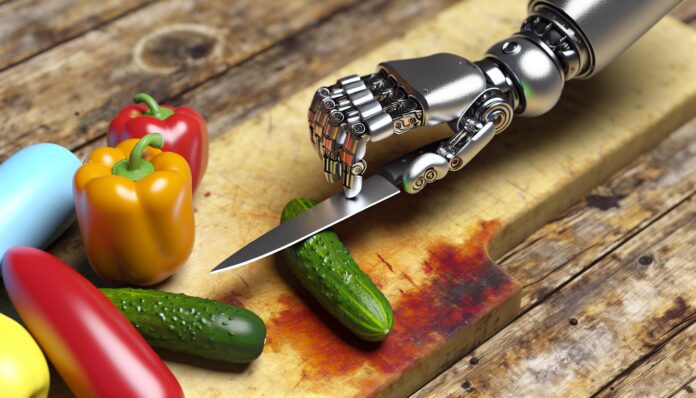The Unexpected Science of the Perfect Slice
In a groundbreaking robotic experiment, an innovative tech enthusiast sought to finally settle the age-old debate surrounding the best chef’s knife for modern kitchens. By attaching 21 of the most popular chef’s knives to a sophisticated slicing robot arm, this project generated unprecedented data-driven insights. Most importantly, this experiment eliminates personal bias and human inconsistency, because it leverages technology to provide a standardized cutting environment.
The approach taken in this study not only enhances understanding of knife performance but also underlines the importance of precision in testing tools that many professionals rely on every day. Therefore, the experiment stands as a perfect example of how modern robotics can intersect with everyday culinary challenges, delivering evidence-backed recommendations for both professional chefs and home cooks alike.
Why Use a Robot Arm for Testing Chef’s Knives?
Most importantly, human testing involves inherent variability. Human technique, fatigue, and personal judgment can all introduce errors. Because the robotic arm delivers repeatable, consistent force and motion, it eliminates these variables. This method, as echoed in a detailed study by Iowa State University, showcases how robotic precision can lead to accurate and impartial results.
Furthermore, this technological approach enhances the robustness of the testing process. As robotics evolve, these systems are increasingly capable of replicating human dexterity, making them a vital tool in product research. Besides that, the enhanced automation paves the way for more rigorous scientific evaluations. For additional insights into performance comparison, you might visit the engaging review on YouTube.
The Testing Setup: Precision Meets Ingenuity
To ensure the utmost accuracy, the experiment involved over 525 cutting trials using the robotic system. Each knife was meticulously mounted onto the robot’s hand, achieving perfect alignment with a standardized grip. Because calibration routines were strictly followed, starting and stopping points were precisely determined, ensuring that no extraneous factors such as blade flex or surface irregularities interfered with the trials.
Moreover, custom 3D-printed guides were integrated into the testing setup to secure the food items during each slice. This innovation not only prevented any chance of rolling or slippage but also allowed the robot to exert its maximum slicing power, leading to more reliable data. Most importantly, by eliminating these variables, the testing platform clearly highlighted every blade’s true performance details.
Assessing Knife Performance: What Really Matters?
In every trial, advanced sensors recorded crucial performance metrics such as the force required per cut, consistency across repetitive motions, and the cleanliness of each slice. Because the effect of manual error was removed, the experiment focused solely on the engineering behind each blade. Therefore, the data truly reflected factors like material quality, blade geometry, and factory edge quality.
This detailed experiment generated over 100,000 data points, and aside from confirming that expensive does not always mean superior, it also revealed that even mid-range knives could excel with exemplary design. For further information on innovative knife evaluation methods, you can explore the Quantified Knife Project. Besides that, statistical analysis of the collected data showed how a subtle convex edge or an optimized handle angle could determine the effectiveness of a knife, especially when dealing with delicate foods such as tomatoes or cheeses.
Lessons from Robotics for the Modern Kitchen
This experiment not only revolutionizes how we assess kitchen tools but also provides a glimpse into the future of culinary technology. Because robotics can replicate human dexterity with precision, future kitchens may soon incorporate similar systems for everyday culinary tasks. More importantly, this data-driven approach could eventually expand to include safety assessments and ergonomic evaluations, ensuring that every kitchen tool is both effective and safe to use.
Furthermore, the integration of robotics in product testing highlights the convergence of robotics and culinary arts. As demonstrated by research in both academic and industrial settings, including those shared by Iowa State University, science-backed assessments can drive innovation in product design. Therefore, such experiments are critical for moving towards a future where technology and culinary expertise work hand in hand.
Final Thoughts: Data-Driven Knife Recommendations
The essence of this experiment lies in the clear demonstration that data trumps hype when selecting the right tool for your kitchen. The experiment revealed that performance is not solely dictated by brand names or price tags. Because every knife was tested under the same conditions, consumers can now make informed decisions based on tangible performance metrics.
Besides that, this robotics experiment serves as a benchmark for future product testing methodologies. It encourages us to rely on rigorous scientific methods for consumer decision-making rather than subjective opinions. Consequently, next time you are thinking of upgrading your kitchen arsenal, let the robust evidence guide your choices. For those interested in the intersection of art, design, and performance, a fascinating read on the artistry of knife design is available at Robe de mariée: deuxième essayage collection Elsa Gary, which, although primarily focused on fashion, provides insight into precision and design aesthetics.
References
- Gripping a Kitchen Knife on the Cutting Board – Iowa State University
- How do the most popular chef’s knives actually perform? – YouTube
- About the Quantified Knife Project – Seattle Ultrasonics
- Robe de mariée: deuxième essayage collection Elsa Gary
In addition, recent insights have emerged from diverse sources including cultural projects such as the initiative detailed at Сайн хашаа. These varying perspectives enrich the discussion by illustrating how performance and design are appreciated across different contexts and industries.



